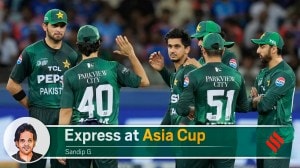In absence of states’ active support, NCC struggles to deliver
CHANDIGARH, April 20: Marching down the Rajpath in full military splendour, the National Cadet Corps or ``future of the nation'', as the com...

CHANDIGARH, April 20: Marching down the Rajpath in full military splendour, the National Cadet Corps or “future of the nation”, as the commentator affirms, presents an inspiring picture. But behind the facade of magnificent quarter-guards and impeccable cadet lines of its various directorates at the camp, lies another tale.
The country’s premier youth organisation and the largest student body is out on a limb. Lack of budgetary support from some state governments, inadequate facilities and a little or no incentives have resulted in the NCC losing its charm among the youth in many states.
Conceived to develop traits of leadership, character and comradeship among the student community and officer-like qualities, besides creating a second line of defence, the NCC is no longer being given due importance.
A voluntary organisation, the Corps came into being in 1948 by an Act of Parliament as a result of the H N Kunzru Committee recommendations. It has three Divisions — Senior Division (SD) for college students, Junior Division (JD) for school students and the Girls’ Division (GD). Each division has three wings — Army, Navy and Air.
Apart from basic military training, including drill, field craft and handling weapons, NCC cadets are exposed to a multitude of activities like power flying, scuba diving, parachuting, trekking, mountaineering and sailing.
To this extent, there are a total of 756 NCC units, including 58 naval units and 58 air squadrons, under 16 directorates. A directorate, which comprises one or more states, is headed by an officer of the rank of a Brigadier.
Training is provided by personnel drawn from the Services. The expenditure on NCC is shared between the central and state governments. While the centre bears the expenditure on pay and allowances of military personnel drafted to the NCC, equipment and stores, weapons, ammunition and service vehicles, the states incur expenditure mainly on pay and allowances of civilian staff, NCC units’ office accommodation, equipment, amenity grants, cost of petrol and oil, refreshment allowance for cadets, training for Associate NCC Officers (ANOs), and 50 per cent of expenditure on camps.
It is the states’ part in running the NCC that’s creating problems. While some states accord a high priority to NCC, many have relegated the organisation to the background.
This has led to poor response from the youth as well as the teaching community, which provides the link between the cadets and the organisation. This is apparent from a shortfall of ANOs.
Officials at the Punjab, Haryana, Himachal Pradesh and Chandigarh NCC Directorate here, complain that budgetary support and incentives from these states are lacking.
"There are hardly any incentives here which would attract cadets. States like Maharashtra, Karnataka and Gujarat provide for reservations in professional colleges and certain government jobs for `C’ Certificate-holders, besides scholarships and some monetary benefits," an officer said.
With an authorised Senior Division strength of 29,750, the posted strength of this directorate is 25,958 cadets. The Junior Division strength is 57,291 against a vacancy for 64,150. For senior girls, the posted strength is 6,493 against a vacancy of 7,520, while for junior girls, the current strength is 4,551 against the authorised 5,900. Out of this aggregate, only 1,054 obtained `C’ Certificates — the highest qualification for a cadet, for which, besides three-year service, the cadet has to qualify in a written and a practical exam.
As per records, the number of NCC cadets from this directorate who joined the services during 1996 – 97 was just 10.
Recently, Army Wing `C’ Certificate-holders, have been allowed to appear directly for SSB interviews for entry into the Officers Training Academy. NCC officers say that this incentive, offered with a view to overcome the officer shortfall in the Army, is a central government initiative. Earlier, only Air Wing `C’ Certificate-holders were allowed to bypass the written entrance exam.
Officers also say that the funds are also not released in time, creating several problems. An officer pointed out that the Punjab contingent for this year’s Republic Day Camp was unsure of its departure till the last day, as the funds for the camp had not been released.
The directorate also has a shortfall of 115 ANOs in the Senior Division and 147 in the Junior Division. Their authorised strength is 455 and 715 respectively.
Another major problem faced by personnel drafted to the NCC is accommodation, especially in non-military station. Called Permanent Instructional Staff, many make do in converted barracks on office premises. Inadequate communication facilities between headquarters and its units located across the district is another sore point.
This directorate won seven gold medals and an equal number of silvers, topped by the coveted trophy for aero-modelling at the prestigious Republic Day Camp at Delhi. In addition, it topped at the National Independence Golden Jubilee Cadet Corps Games held at Delhi in August last, with five trophies, eight gold and six silver medals. This, officers say, is more of an individual effort of the cadets rather than substantive state support.
Photos


- 01
- 02
- 03
- 04
- 05





























